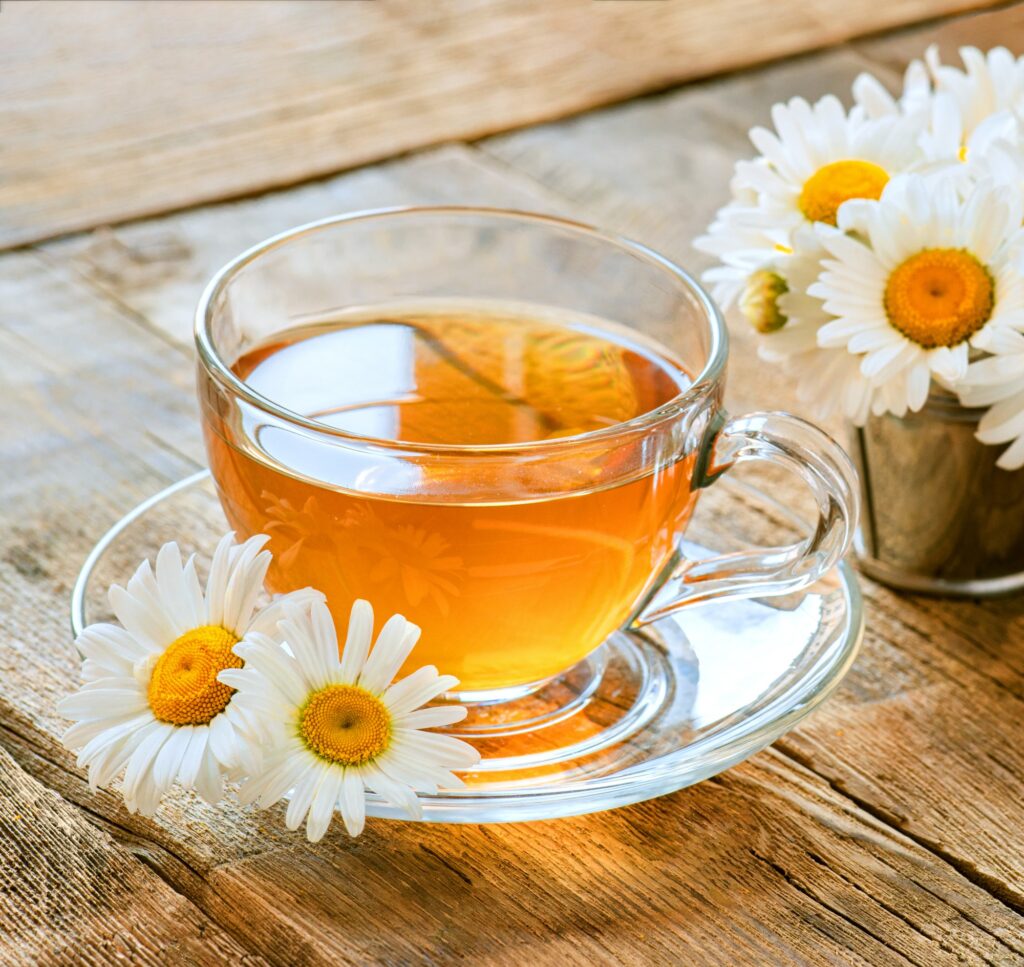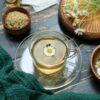
In the realm of herbal teas, chamomile stands as a timeless classic, revered for its soothing properties and delightful aroma. Known by its Spanish name, “manzanilla,” this gentle infusion has graced the cups of countless individuals seeking comfort and relaxation. Chamomile tea, with its golden hue and delicate floral notes, has long been a beloved companion for those seeking respite from the stresses of daily life.
Originating from the daisy-like chamomile plant, this herbal tea has woven itself into the fabric of various cultures, each with its own unique traditions and preparations. From ancient Egypt, where it was used in religious ceremonies, to modern-day households around the globe, chamomile tea has transcended time and borders, offering a natural remedy for a myriad of ailments.
Whether you refer to it as chamomile or manzanilla, this fragrant infusion holds a special place in the hearts and cups of tea enthusiasts worldwide. Its gentle embrace and soothing qualities have earned it a well-deserved reputation as a go-to beverage for those seeking tranquility and well-being.
History and origin of chamomile tea
The history of chamomile tea is as rich and captivating as its flavor. Tracing its roots back to ancient civilizations, this herbal infusion has been cherished for centuries, transcending cultures and continents.
- Ancient Origins: Chamomile’s journey can be traced back to ancient Egypt, where it was revered for its medicinal properties and used in religious ceremonies. The Egyptians believed in the plant’s ability to promote longevity and vitality, and it was often incorporated into their embalming practices.
- Spread Through Trade Routes: As trade routes expanded, chamomile found its way across the Mediterranean region and into Europe. The Romans and Greeks embraced its use, recognizing its calming effects and incorporating it into their daily lives.
- Medieval Monasteries: During the Middle Ages, chamomile cultivation flourished in the gardens of monasteries, where monks meticulously tended to the plants and harnessed their healing properties. The knowledge of chamomile’s benefits was preserved and passed down through generations of herbalists and apothecaries.
- Global Popularity: With the Age of Exploration, chamomile tea’s popularity spread to the Americas and beyond. Today, it is cultivated and enjoyed in various regions around the world, with each culture adding its own unique twist to the preparation and consumption of this beloved beverage.
From ancient rituals to modern-day tea cups, chamomile tea has woven a tapestry of tradition and healing, transcending boundaries and captivating the hearts of tea lovers across the globe.
Health benefits of chamomile tea
Beyond its soothing aroma and delightful taste, chamomile tea offers a wealth of potential health benefits that have been celebrated for centuries. Here are some of the most noteworthy advantages associated with this beloved herbal infusion:
- Promotes Relaxation and Sleep: One of the most well-known benefits of chamomile tea is its ability to promote relaxation and aid in restful sleep. The compounds present in chamomile, such as apigenin, have been shown to have mild sedative effects, helping to calm the mind and alleviate anxiety and stress.
- Anti-inflammatory Properties: Chamomile tea is rich in antioxidants and has potent anti-inflammatory properties. These properties can help reduce inflammation in the body, potentially offering relief from conditions like arthritis, muscle pain, and menstrual cramps.
- Digestive Support: Chamomile tea has been traditionally used to soothe digestive issues such as bloating, indigestion, and irritable bowel syndrome (IBS). Its anti-inflammatory and antispasmodic effects can help relax the digestive tract and alleviate discomfort.
- Skin Health: The anti-inflammatory and antimicrobial properties of chamomile make it a popular ingredient in skincare products. It can help soothe skin irritations, reduce redness, and promote healing of minor wounds and burns.
- Immune System Support: Chamomile tea contains compounds that may help boost the immune system and fight off infections. Its antioxidant properties can help neutralize free radicals and protect the body from oxidative stress.
- Potential Cancer-Fighting Properties: Preliminary research suggests that chamomile may possess cancer-fighting properties due to its antioxidant and anti-inflammatory compounds. However, more research is needed to fully understand its potential in this area.
While more research is still needed to fully understand the extent of chamomile tea’s health benefits, its long-standing tradition and widespread use as a natural remedy speak volumes about its potential positive impact on overall well-being.
The soothing effects of chamomile tea on the body and mind
Chamomile tea’s soothing properties extend beyond its physical benefits, offering a gentle embrace for both the body and mind. Its calming effects have made it a beloved companion for those seeking respite from the stresses of daily life.
- Relaxation and Stress Relief: The warm, fragrant aroma of chamomile tea can instantly transport you to a state of tranquility. Its mild sedative properties help to calm the mind and alleviate feelings of anxiety and tension, promoting a sense of relaxation and well-being.
- Improved Sleep Quality: For those struggling with insomnia or restless nights, chamomile tea can be a natural sleep aid. Its gentle sedative effects can help quiet the mind, promote relaxation, and encourage a more restful slumber.
- Digestive Comfort: The anti-inflammatory and antispasmodic properties of chamomile tea can soothe digestive discomfort, alleviating symptoms such as bloating, indigestion, and cramping. Its calming effects can help relax the digestive system, promoting a more comfortable and peaceful digestive experience.
- Mood Enhancement: Chamomile tea’s ability to promote relaxation and reduce stress can also have a positive impact on mood. By alleviating feelings of anxiety and tension, it can help foster a sense of calmness and emotional balance.
- Muscle Relaxation: The anti-inflammatory properties of chamomile tea can help soothe sore muscles and alleviate muscle tension. Its calming effects can promote relaxation and aid in recovery after physical activity or periods of stress.
Whether you’re seeking a moment of tranquility after a long day or a gentle companion to help you unwind before bedtime, chamomile tea offers a soothing embrace for both the body and mind, inviting you to experience a state of peaceful serenity.
Different types of chamomile tea and their unique properties
While chamomile tea is often associated with its classic golden hue and delicate floral aroma, there are actually several distinct varieties of chamomile, each with its own unique properties and characteristics. Here’s a closer look at some of the most popular types of chamomile tea:
- German Chamomile (Matricaria recutita): This is the most commonly known and widely cultivated variety of chamomile. German chamomile tea is characterized by its bright golden color, sweet and slightly fruity aroma, and mild, slightly bitter taste. It is highly regarded for its soothing and anti-inflammatory properties.
- Roman Chamomile (Chamaemelum nobile): Roman chamomile tea has a more robust and earthy flavor compared to its German counterpart. It is known for its deep blue-green color and intense, slightly sweet aroma. Roman chamomile is often praised for its calming and sedative effects, making it an excellent choice for promoting relaxation and restful sleep.
- Egyptian Chamomile (Matricaria chamomilla): Originating from the Nile Valley region, Egyptian chamomile tea has a distinct, slightly more bitter taste and a stronger aroma compared to other varieties. It is highly valued for its potential therapeutic properties, including its anti-inflammatory and digestive benefits.
- Wild Chamomile (Matricaria maritima): As the name suggests, wild chamomile grows naturally in various regions around the world. Its flavor is often described as more robust and earthy, with a slightly more pronounced bitterness compared to cultivated varieties. Wild chamomile tea is prized for its potent antioxidant properties and potential immune-boosting benefits.
- Manzanilla Chamomile (Matricaria recutita): Manzanilla is the Spanish term for German chamomile, and this variety is widely cultivated and consumed in Spain and Latin American countries. Manzanilla chamomile tea is known for its delicate, slightly sweet flavor and gentle, soothing properties.
Each type of chamomile tea offers its own unique flavor profile and potential benefits, allowing tea enthusiasts to explore and appreciate the diversity within this beloved herbal infusion.
How to brew the perfect cup of chamomile tea
Brewing the perfect cup of chamomile tea is an art form that combines the right ingredients, techniques, and personal preferences. Here’s a step-by-step guide to help you unlock the full potential of this soothing beverage:
- Choose High-Quality Chamomile: Start with fresh, high-quality chamomile flowers or tea bags. Look for chamomile that is fragrant and vibrant in color, as this will ensure the best flavor and aroma.
- Use Fresh, Filtered Water: The quality of the water you use can greatly impact the taste of your chamomile tea. Opt for fresh, filtered water to avoid any undesirable flavors or impurities.
- Warm the Teapot or Cup: Before brewing, warm your teapot or cup by rinsing it with hot water. This will help maintain the optimal temperature for steeping and prevent the tea from cooling too quickly.
- Measure and Steep: For loose chamomile flowers, use approximately 1 teaspoon per cup of water. If using tea bags, follow the recommended steeping instructions on the package. Steep the chamomile for 5-7 minutes, allowing the flavors and beneficial compounds to fully infuse into the water.
- Adjust Steeping Time for Desired Strength: If you prefer a stronger or more robust flavor, extend the steeping time by a minute or two. For a milder, more delicate taste, reduce the steeping time slightly.
- Add Sweeteners or Flavorings (Optional): While chamomile tea is delightful on its own, you can enhance its flavor by adding a touch of honey, lemon, or other natural sweeteners or flavorings to suit your personal taste preferences.
- Savor the Aroma and Flavor: Once brewed, take a moment to appreciate the delicate aroma of the chamomile tea. Sip slowly and mindfully, allowing the soothing flavors to envelop your senses.
Remember, brewing the perfect cup of chamomile tea is a personal journey, and experimenting with different techniques and flavors can help you discover your ideal cup. Embrace the ritual of preparing and enjoying this timeless beverage, and let it transport you to a state of tranquility and relaxation.
The role of manzanilla in chamomile tea
While the term “chamomile” is widely recognized, the Spanish word “manzanilla” holds a special place in the world of this beloved herbal infusion. Manzanilla is the Spanish name for the German chamomile variety (Matricaria recutita), and it plays a significant role in the cultural traditions and preparations of chamomile tea in Spain and Latin American countries.
- Cultural Significance: In Spanish-speaking regions, manzanilla is deeply ingrained in the cultural fabric. It is a common household staple, often used as a natural remedy for various ailments and as a soothing beverage to promote relaxation and sleep.
- Traditional Preparations: The preparation of manzanilla chamomile tea is steeped in tradition. In Spain, it is common to brew a strong infusion by steeping the dried flowers for an extended period, resulting in a rich, flavorful tea. In Latin American countries, manzanilla may be combined with other herbs or spices, such as lemon verbena or cinnamon, adding unique flavor profiles.
- Medicinal Uses: Manzanilla chamomile tea is widely recognized for its potential medicinal properties in Spanish and Latin American cultures. It is often used to soothe digestive issues, alleviate menstrual cramps, and promote relaxation and sleep.
- Emotional and Spiritual Connections: Beyond its physical benefits, manzanilla holds emotional and spiritual significance in many Spanish and Latin American communities. It is often associated with comfort, nurturing, and a sense of home, serving as a warm embrace during times of stress or illness.
- Culinary Applications: In addition to its use as a beverage, manzanilla chamomile is also incorporated into various culinary dishes and preparations. It may be used to infuse flavor into rice dishes, soups, or even desserts, adding a unique and delicate floral note.
Whether enjoyed as a soothing cup of tea or incorporated into cultural traditions and remedies, manzanilla chamomile holds a special place in the hearts and homes of Spanish and Latin American communities, serving as a testament to the enduring power and versatility of this beloved herbal infusion.
Manzanilla chamomile tea and its specific benefits
While all varieties of chamomile tea offer a range of potential benefits, manzanilla chamomile, the Spanish name for German chamomile (Matricaria recutita), has garnered particular recognition for its unique properties and therapeutic applications. Here are some of the specific benefits associated with manzanilla chamomile tea:
- Digestive Support: Manzanilla chamomile tea is widely renowned for its ability to soothe digestive issues. Its anti-inflammatory and antispasmodic properties can help relieve symptoms such as bloating, indigestion, and cramping, making it a popular choice for those seeking digestive relief.
- Menstrual Cramp Relief: Many women turn to manzanilla chamomile tea as a natural remedy for menstrual cramps. Its anti-inflammatory and relaxing properties can help alleviate muscle spasms and discomfort associated with menstrual cycles.
- Sleep Aid: The mild sedative effects of manzanilla chamomile tea make it an excellent choice for promoting restful sleep. Its calming properties can help quiet the mind, reduce anxiety, and encourage a more peaceful slumber.
- Stress and Anxiety Relief: The soothing aroma and relaxing qualities of manzanilla chamomile tea can help alleviate feelings of stress and anxiety. Its ability to promote relaxation and calm the mind make it a popular choice for those seeking a natural way to unwind and find inner peace.
- Skin Soothing Properties: Manzanilla chamomile tea is often used topically for its skin-soothing properties. Its anti-inflammatory and antimicrobial compounds can help alleviate skin irritations, rashes, and minor burns, promoting healing and providing relief.
- Wound Healing: The antimicrobial and anti-inflammatory properties of manzanilla chamomile tea make it a potential aid in wound healing. When applied topically, it can help prevent infection and promote the healing process of minor cuts, scrapes, and wounds.
- Respiratory Support: Some research suggests that manzanilla chamomile tea may offer benefits for respiratory health. Its anti-inflammatory properties may help alleviate symptoms associated with conditions like bronchitis and asthma, although more research is needed in this area.
While these benefits are promising, it’s important to note that individual responses may vary, and it’s always advisable to consult with a healthcare professional, especially if you have any underlying medical conditions or are taking medications.
Where to buy chamomile tea and manzanilla chamomile tea
As the popularity of chamomile tea continues to grow, finding high-quality chamomile and manzanilla chamomile tea has become increasingly accessible. Here are some options to consider when sourcing your favorite chamomile tea varieties:
- Specialty Tea Shops: Many local and online specialty tea shops offer a wide selection of chamomile tea varieties, including manzanilla chamomile. These shops often prioritize sourcing high-quality, fresh ingredients and may provide detailed information about the origin and processing methods of their teas.
- Health Food Stores: Health food stores and natural grocery chains typically carry a range of chamomile tea options, including loose leaf and tea bags. Look for organic or sustainably sourced chamomile to ensure the highest quality and purity.
- Online Retailers: Online retailers have made it convenient to purchase chamomile tea from the comfort of your home. Reputable online stores often offer a diverse selection of chamomile varieties, including manzanilla chamomile, and may provide detailed product descriptions and customer reviews.
- Local Markets and Farms: If you have access to local farmers’ markets or farms that cultivate chamomile, this can be an excellent source for fresh, locally grown chamomile flowers or tea blends. Supporting local growers can also contribute to sustainable agricultural practices.
- International Specialty Stores: For those seeking authentic manzanilla chamomile tea from Spain or Latin American countries, international specialty stores or online retailers that specialize in imported goods may offer a wide range of options.
When purchasing chamomile tea, it’s essential to pay attention to the freshness and quality of the product. Look for vibrant colors, strong aromas, and clearly labeled packaging that provides information about the tea’s origin and processing methods.Embark on a soothing journey by exploring the world of chamomile tea and manzanilla. Discover the perfect blend that resonates with your taste and wellness needs, and let the calming embrace of this timeless herbal infusion become a cherished part of your daily routine. Experience the tranquility and rejuvenation that a cup of chamomile tea can bring, and elevate your self-care rituals to new heights.
Incorporating chamomile tea into your daily routine
Incorporating chamomile tea into your daily routine can be a simple yet profoundly nourishing act of self-care. This gentle herbal infusion offers a multitude of potential benefits, from promoting relaxation and aiding sleep to supporting digestive health and soothing the mind and body.
As you embark on your chamomile tea journey, consider creating a calming ritual around your tea-drinking experience. Set aside a dedicated time and space to savor each sip, allowing the soothing aroma and flavors to envelop your senses. Experiment with different varieties, such as manzanilla chamomile, to discover your personal preferences and appreciate the nuances of each blend.
Remember, the true power of chamomile tea lies not only in its physical benefits but also in the mindful act of slowing down and embracing moments of tranquility. Use this time to practice deep breathing exercises, engage in gentle stretching, or simply bask in the present moment, free from the distractions of daily life.
Incorporating chamomile tea into your daily routine can also serve as a reminder to prioritize self-care and nurture your overall well-being. Whether you enjoy a cup in the morning to start your day with a sense of calm or wind down in the evening with a soothing chamomile blend, this simple ritual can become a cherished part of your self-care practice.
So, embrace the soothing embrace of chamomile tea and let it guide you on a journey of relaxation, healing, and inner peace. With each fragrant sip, you’ll be nourishing not only your body but also your mind and spirit, cultivating a deeper connection with yourself and the world around you.






